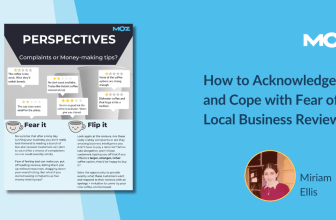Best of Whiteboard Friday 2021: UTM Tagging for Google My Business

[ad_1]
The author’s views are entirely his or her own (excluding the unlikely event of hypnosis) and may not always reflect the views of Moz.
As we wind down 2021, we’re taking a look back at the most popular Whiteboard Friday episodes from the year. First up, from August, small business SEO expert Claire Carlile walks you through the what, why, where, and how of UTM tagging for your GMB profiles.
Editor’s note: Beginning at 1:49, when Claire mentions “referral traffic”, it should be “referral information”.
Video Transcription
Hey, Moz fans, and welcome to another edition of Whiteboard Friday. Do you have a Google My Business listing or do you work with clients that have Google My Business listings, and do you want to know more about the value of the traffic that Google My Business drives to your website?
Well, if you do, this is the Whiteboard Friday for you. So I’m Claire Carlile, and I am a local search expert at BrightLocal, and today I’m going to speak about UTM tagging for Google My Business.
What’s a UTM tag?
So you might be asking, “What is a UTM tag?” If you are, you wouldn’t be the first person to ask that question.
So UTM stands for Urchin Tracking Module. But if you just think of UTM tags as tracking codes that we add to the end of our external links that tell us more about where that traffic came from and how it got to our websites. So when someone clicks on a UTM tagged URL, details of the source, the medium, and the campaign that that website visit comes from get transferred over into Google Analytics.
Why add UTM tags?
So why would we want to add UTM tags to our GMB URLs? Well, without tagging, all of the traffic will end up in the Organic bucket. So that’s fine, but what it won’t tell us is whether that organic traffic came from the regular organic results or whether it came from Google My Business URLs in the business profile or in Google Maps.
Another reason is that many mobile apps and browsers don’t give their referral traffic into Google Analytics, and that traffic is just going to end up in the Direct bucket. We’re marketers. We’re very used to having to demonstrate our value and the value of our services. So this is a great way for you to illustrate the value that you’re adding to your client or to your organization.
We also often need to secure a budget. So whether that budget is for more of our time or it’s for photos or videos for Google My Business, it also lets us understand the value of various Google My Business features so we can say Google Posts is more valuable to this client than Google products, or Google products refers less traffic but at a rate that converts higher.
Also, we’ll get the Google Search Console data for those UTM tagged URLs. So we’ll see the query data. We’ll see what queries are actually driving impressions and clicks on these UTM tagged URLs.
Where can you tag?
So let’s think about what we can tag. We hear a lot about zero-click search, but that really isn’t a new concept if you’ve been working in local search for a while, because from the business profile a potential customer can click to call a business, they can download driving directions, they can look at photos, they can read reviews, they can look at services, all without clicking through to the business website.
But that said, we do actually have a lot of opportunities in GMB to link back to our website and to drive traffic to the website. So what you have in GMB will be dependent upon your primary category.
But most businesses will have a website link. They might have an appointment or a menu URL. They might have Google products. They might have Google Posts. You might be using the new follower offer, which not a lot of people know about and even less people are using, and it might actually die and end up in the Google graveyard, but it only takes 10 minutes to set up. So if you have the type of business that could attract a local following, then it’s worth adding because you can see: Does it actually drive value for the business? What does that traffic do when they get to your website? What content are they looking at? Where are they moving, and how are they moving around? Is the traffic from GMB actually driving revenue? Are they buying things when they get to your website? Then we’ve got all of our conversions and micro conversions that hopefully we have set up so we can measure in Google Analytics.
So do we get click to call? Do we get click to email? Do they download a resource? Do they click through to our social media profiles? Do they fill in a form? Do they sign up for our newsletter? We can find out all of these things when we add UTM tagging.
UTM tagging tips
So I’m going to give you some UTM tagging tips because I think the most important thing is to be very, very consistent from the outset, because it’s quite easy to get this wrong.
So consistency being key, think about how you’re going to separate out your words. I like to use a dash. Some people like to use an underscore. Whatever you use, just make it very consistent.
Then we have uppercase and lowercase letters. So I always stick with lowercase letters, the reason being that Google Analytics is case sensitive in all of its reports. So if you’re using a mix of uppercase and lowercase, Google is going to report upon that separately. If you don’t get this right, you’re going to be dealing with a lot of messy and bought data that you’re going to have to sort out outside of Google Analytics, and you really don’t want that.
So another thing is if you get your source and your medium in a muddle, then that traffic is just going to end up in the Other bucket, which is pretty much totally sad times. So a way to avoid that is by thinking of the source as where the journey started or where that traffic came from and the medium as the method of transport. It’s how that traffic got from A to B.
Who manages the data?
So before we think about which URLs on our website we’re going to tag up, we need to think about who is managing the data and reporting in our organization or in our client’s organization, because the UTM tags and the framework that you set up need to play nicely and sit within their framework. You don’t want to be robbing clicks from them if they’re trying to demonstrate the value of something.
Now you might find that when you work with small and medium-size businesses, no one is managing the data and reporting, in which case happy days, this will work absolutely fine.
Which URLs do you tag?
So which URL will you tag?
Well, there are some questions here. Do you have one location, or do you have many locations? So if it’s just one location, you probably tag up your homepage. If it’s many locations, you’re going to be linking to your location landing pages.
If you’re using Google products, then you’ll be wanting to link to your products or your services pages.
If you have an appointment URL, then you will be linking through to maybe the Contact Us page. If you have booking or appointment functionality on your website, you’ll link to that page.
Now, unsurprisingly, the menu URL will link to your menu page.
If you’re using Google Posts, have a think about where will you link to. If it’s a special offer post, is there a special offer page that it will link to? When that special offer expires, what will you do with that page? Will it continue to resolve, or are you going to 301 it somewhere else? Plan all that out beforehand. Actually, you need to make sure that you check the URL that you’re wanting to link to. Are you linking to the correct version? If you’re on https, which I hope you are, you won’t want to be linking to the http.
You need to look: Does that page resolve? Can you see everything on that page? Does that page give a 404, in which case obviously we’re not going to want to link to it? Does that page go through a series of redirects? Now, a series of redirects is going to strip the UTM tagging off of that URL, and we really don’t want that.
How to tag
So once you’ve checked which URLs you need to link to, you’re actually going to tag those up.
So for the source, I’m using Google. Some people like to use GMB. But whatever you choose, again, make sure it fits within this framework and be consistent from the outset. For medium, I’m using organic. Then for campaign, I’m using that field to describe the location of that link within Google My Business.
So it might be the primary website link, menu, products, or the appointment. If you’re using the new follower offer, you have this. Then with Google Posts, I like to be a little bit more granular so I can see what type of posts might be working the best, and I can also track any changes when Google starts moving posts up and around inside the business profile.
So we’ve got the what’s new post, the offer post, and the event post. Finally, for Google Posts, using the campaign content field to describe the actual content of that post. So if you work with a business which has lots of unique and interesting content, you might just need to describe that content, so summer-21-sale, free-giraffe-rides, curry-night-may-21, or you might just like to use the date there in the campaign content field.
So top tip is if you’re using Posts, you have access to Posts, I hope you’re using them, then using a Google Sheets add-on called Postamatic, which is brilliant, it allows you to schedule your posts, and it also automatically adds UTM tagging within this format. So it’s very much recommended.
So you’re going to tag up your GMB URLs and those links with UTM codes. So you might use something like Google’s Campaign URL Builder, which is something that I used to use when I first started tagging up business profiles. But since then I’ve been working on my UTM Tagging Guide with the Google Sheet, which is basically my gift to you with love.
So you can use that to keep everything nice and tidy and everything in one place. It auto-generates the tag. So all you have to do is just drop your URL into the sheet, and then it will give you the UTM codes for those URLs. It’s a good way to keep a record of what you’re adding, and that might be Google Posts, if you’re not using Postamatic.
It might be your Google products. You have a record then, and you can understand what type of content resonates, what doesn’t, and what you could do better with your content. So you will find that guide and sheet here, on this URL.
So that’s it for today. I hope you found that useful and hopefully see you here again soon.
[ad_2]
Source link





